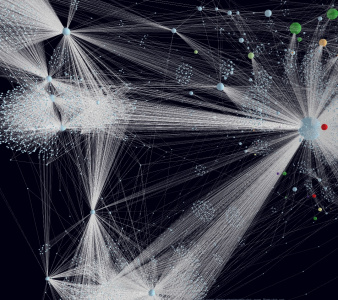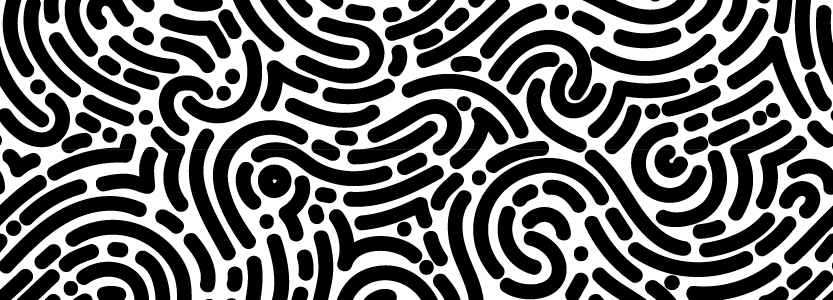The cosmos of illustrated periodicals
Béatrice Joyeux-Prunel & Nicola Carboni
Are illustrations that look alike always published in the same types of magazines? Or do they cross disciplines and social circles? Are they able to cross borders, or are they condemned to national visual spaces?
A cosmic visualisation...
This would allow us to enter into the subject and to better understand what connects the images in globalization; a cartography in space and time is likely to help locate constellations, stars that are brighter than others, meteorites, mobilities as well as fixities in this multidimensional space that our images construct.
It took us some time to obtain the most suitable visualization: a spatial representation of these thousands of illustrated periodicals that we have gathered, linked to each other according to the cities that share their publication. All that is left to do is to move around in this space and observe its geography.
Cities in networks

A graph showing the different magazines published in each city. Each color represents a different type of magazine

First of all, we note that some agglomerates are larger than others.
They reflect the over-representation of certain cities in the corpus whose images we have explored and compared. More precisely, certain cities clearly played a more important role in an internationally shared visual culture at the beginning of the 20th century. Paris, Toulouse, New York, Marseille, Mulhouse, Buenos Aires, Hanoi, Tokyo, Barcelona, Cincinnati are the ten most represented cities. We did not imagine that we would have collected so many images for Hanoi, Buenos Aires, Cincinnati or Mulhouse and Toulouse. This is partly an effect of the source (certain journals are more accessible digitally for certain places, notably Paris), but also the effect of the over-representation of certain cities in the circulation of images from all over the world. An effect, therefore, of the system of production of printed images in the early 20th century.
The circulation of images?
A very national rationale, still.
If certain groups of images connect cities, it is usually within the same country. The logic of the circulation of images is first and foremost very national.
The titles of the large-circulation illustrated press disseminate visual corpuses that hardly cross borders.
Advertising in particular, which was particularly widespread in these press organs, followed an equally national logic until the 1950s. We will come back to this in another chapter.
Only a few images cross borders and bring together periodicals of very different national origins.
However, we can already notice certain trends.
Images from Germany are more interconnected with those from Eastern Europe and the American world. The visual circulation between Turin, Warsaw, Munich, Gdansk, Stuttgart and Heidelberg (to name the most present) is evident.
Another important trend in our data is the role of Paris as a gateway to the French world.
While visual production is quite diffuse and present throughout the country, visual exchanges at the international level have Paris as their main protagonist.

--
Above is a graph showing the exchange of images between different cities/countries. In green are cities in the USA, in red those in Germany and in light blue those in France. The details are more visible in the image below, which shows a rich interconnection of image clusters between different US, German, Polish and Austrian cities. Note the role of Paris as the main interconnection between these countries and France.
--



Network visualization
Which images cross borders best? To see this better, let's change the frame of reference of our computational cosmos, by dividing our groups of images according to the preferred fields of the journals in which the images are published. We have chosen to color the magazines according to their type (art magazine, illustrated newspapers, women's magazine, daily newspapers, avant-garde magazines, etc.).
In the first part of the twentieth century, it was primarily through art magazines that images crossed borders.

--
This graph illustrates the interconnection between our periodicals and the groups of nearby images isolated by the machine (clusters). The nodes are colored according to the type of journal considered. The widespread presence of green and pink nodes highlights the role in the international circulation of images of art and modern art journals. The third group of journals that circulates the most images between periodicals is that of humorous journals.
--
Art magazines share, on an international scale, the largest number of groups of similar images.
This is quite logical: they often reproduce the same works, especially during certain major international exhibitions, for which they also cover the criticism.
The illustrated newspapers, on the other hand, form very national groups.
Here, it is not similar images that circulate, but exact copies. In France, illustrated newspapers at the turn of the 20th century were often produced by the same Parisian printing house, which distributed them throughout France under different local or regional titles. Our corpus contains only an extract, for the year 1900. We know from the Journal de la société statistique de Paris that the batch could be much larger: as early as 1883 this organ mentions "60 illustrated publications, which under various names, are printed and exploited for publicity by a Parisian company which, in return for a small fee, sends them to provincial newspapers as illustrated supplements".[1]
-
Read more:
EXPLORE, a platform for navigating the images of printed globalization.
Go back:
Our First Results
Chapter:
III. Navigating the Ocean of Images
[1] Journal de la société statistique de Paris, 'Variétés', vol. 24 (1883), chap.1, "La presse française", pp.164-165. URL: http://archive.numdam.org/article/JSFS_1883__24__164_0.djvu, quoted by Elisa Grilli, Revues en réseaux et Renaissance. (Grande-Bretagne, France, Italie, Espagne et Catalogne, 1890-1909), unpublished PhD, université de Versailles-Saint-Quentin en Yvelines, 2022, p.53.

